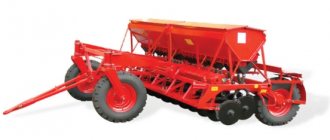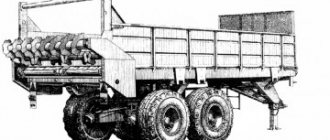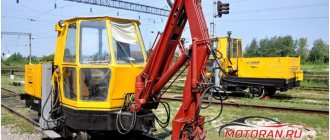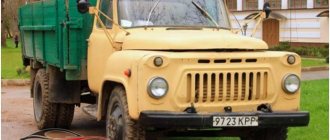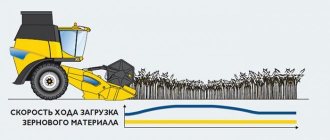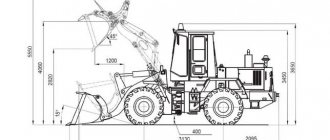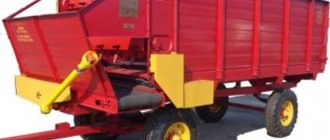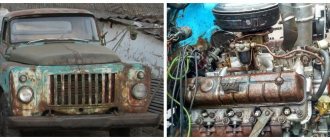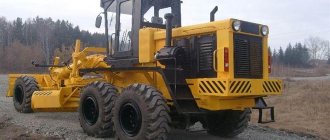The trailed grain seeder SZ 3 6 is widely used in the fields of agricultural enterprises in Russia and neighboring countries. This universal equipment can be used with seeds of grains, legumes and some cereal crops. Suitable for sowing barley, oats, peas, buckwheat, millet and other crops. Among the main advantages is the ability to apply fertilizers to a depth of up to 80 mm simultaneously with sowing. The depth and speed of sowing are controlled by special sensors. The seeder is used with tractors of different traction classes, mainly with MTZ-80 (82) and the like.
Description of equipment
With intensive cultivation technology, to create a tramline, it is possible to overlap part of the cells. SKM and SZ grain-fertilizer seeders are equipped with additional removable units and can be used for a wide range of agricultural work:
- double-disc coulters and harrows - for row seeding;
- single-disc coulters - for overseeding and applying granular fertilizers without loosening the soil;
- two-line point openers and harrows - for crops with a planting depth of 30 mm (flax, legumes, certain types of grains);
- single-line point openers and harrows are designed for light soil types;
- double-disc double-row coulters and chain harrows - for sowing in narrow rows.
It is advisable to purchase grain-fertilizer seeders equipped with all the necessary removable mechanisms. Taking into account the agrotechnical conditions of the region and the characteristics of the composition and moisture of the soil.
Important. Removable equipment units from one manufacturer are not always universal and suitable for all grain and fertilizer seeders.
Design of a grain fertilizer seeder
Based on the mounting method, mounted and trailed grain fertilizer seeders are distinguished:
- trailed structures are designed for cultivating large areas, since it is possible to independently adjust the working width in one pass, connecting from three to six seeders into one structure. Such structures require the use of powerful traction equipment due to the large weight of the structure;
- mounted – for small areas sown with vegetable and beet crops.
The universal design of the grain fertilizer seeder allows you to reduce labor costs, save fuel resources and perform sowing in strict accordance with agrotechnical requirements. Since it is important to maintain the depth of seed placement, taking into account the soil moisture in the region, combining sowing with plowing is not advisable.
It has been proven that all the conditions for proper groundwork can be met only by combining soil loosening without turning over the layer with sowing and the application of granular fertilizers. Final compaction of the soil (rolling) is necessary to preserve the seeds and prevent them from being eaten by birds and weathering.
Machine versatility
The agricultural machine performs three sequential operations:
- Pre-sowing loosening. It is carried out by S-shaped organs borrowed from the classic stubble cultivator. Thanks to them, the “Omichka” we are considering is launched directly onto the stubble on some farms. This is especially true in areas with an increased risk of wind erosion. After grain harvesting in some areas, especially in southern latitudes, there comes a time of strong winds, and irrigation naturally stops. The rise of plowed land after harvesting can provoke the weathering of light particles of dried humus from the soil. In such cases, introducing a fallow catch crop, which also enriches the soil with nitrogen, is the only possible way out of the situation. And the Omichka stubble seeder copes with this task perfectly.
- Actually - sowing. Produced using a time-tested, reliable Kalashnikov-style bobbin seeding device within adjustable limits from 95 to 510 kg/ha.
- Post-sowing rolling. Produced using modern rollers. The point of the process is that the top layer of soil, as expected, becomes compacted, activating the flow of moisture from the aquifers, but the surface itself becomes rough, as if closing off the moisture.
Photo: seeder Omichka SKP 2.1
This is interesting: Single-row and double-row grimme combines for harvesting potatoes: technical specifications, photos and videos
Principle of operation
General operating principle:
- the grooves are cut using the loosening arms of the mechanism;
- in the direction of travel, seeds are dosed into the soil and fertilizers are applied in parallel, for which the container is equipped with two separate compartments with different feeding frequencies;
- the posts level and compact the soil between the rows;
- a beam with teeth located at an obtuse angle located behind the paws levels the soil as it moves. The obtuse angle of the teeth suggests self-cleaning of large clods of earth, plant debris and small rhizomes;
- standard grain fertilizer seeders SKM and SZ have the following parameters - the distance between the teeth is 75 mm, between the paws - 150 mm.
Modern types of seeders can be equipped with attachments with different tooth frequencies for cultivating crops with different requirements for agrotechnical seeding conditions.
SKP 2.1D for No till technology
The classic method of farming involves the implementation of a whole range of mandatory soil cultivation measures before using standard seeders. These include preliminary plowing of the land, which, although useful for reducing the time required for cultivating land and optimizing processes, has negative consequences for the soil.
No till technology eliminates such actions and is designed to reduce mechanical efforts and the costs of maintaining and servicing numerous equipment. You can buy a grain seeder SKP 2.1 “Omichka” and use it within this method. The main principle of No till technology is the refusal of plowing, which means preserving the soil structure, reducing the risk of erosion and maintaining the moisture balance necessary for grain crops.
Grain fertilizer seeder SZ
The SZ-3.6 and SZ-3.6A mechanisms are very popular due to the optimal price-quality ratio. The advantage of this model is a wide range of components and parts for repairing SZ, which can be purchased in any region of the Russian Federation.
SZ-3.5 – advantages and disadvantages:
- possibility of applying fertilizers to a depth of up to 80 mm, simultaneously with sowing work;
- pneumatic wheel drive ensures smooth movement on any surface and accurately adjusts the desired depth of the coulter, without sudden changes in depth;
- equipping with standardizing shaft sensors on the seeding device ensures uniform feeding;
- one operator can control the sowing process and, if necessary, quickly adjust the SZ-3.5;
- when changing openers, which are provided in the SZ-3.5 model, it is possible to simultaneously cultivate different types of plants in narrow rows.
SZ-3.5 is designed for cultivating all types of grains, leguminous and vegetable crops on small areas of farms with complex plot geometry. It features good maneuverability, ease of maintenance, durability and versatility.
Model SZ-3.6A - differences:
- a convenient mechanism for overlapping a separate sowing device is provided to create a tramline;
- SZ-3.6A is easy to modify when changing crops, taking into account the requirements of agricultural technology;
- The seed dosing rate is easily adjusted by changing the length of the coil, changing the rotation frequency of the working shaft or adjusting the seeding valve.
Video: Adjusting the grain sowing rate on the SZ-3.6 seeder
It is convenient to adjust the required fertilizer rate in the SZ-3.6A model by simply moving the handle.
Device
The main technical elements of the Omichka seeder are:
- Supporting frame, which is a metal structure. It consists of spokes and bars on which the opener is mounted.
- A pair of wheels and a stand that are mounted on a support.
- Rollers, which are also the base for the seeder itself. They perform the function of compacting the soil.
- A grain box is a container that is divided into compartments for seeds and fertilizers.
- Seeding device.
- A fertilizer sowing unit that is brought into working position by changing the gap between the valve and the reel.
- The drive is responsible for the rotation speed of the seeding unit shafts.
- Openers, which are the leading working bodies. They serve as a base for attaching the seed tube trays.
- A trailer that overpowers the seeder.
- A hydraulic cylinder that lifts and lowers the seeder.
- Hitches are used to connect seeders to each other.
Technical characteristics of grain fertilizer seeders.
The picture shows a general drawing of the SZ series seeder. Overall dimensions may vary depending on the selected model.
Overall dimensions of SZ and SZT seeders
| Model | Ryadkov | Length | Width | Height | Weight |
| SZ-3.6 SKM | 24 | 1200 | 5000 | 1400 | 1320 |
| NWT-3.6 SCM | 24 | 1200 | 5000 | 1400 | 1580 |
| SZ-5.4 SKM | 36 | 1200 | 6800 | 1450 | 2310 |
| NWT-5.4 SCM | 36 | 1200 | 6800 | 1450 | 2700 |
| SZ-6.0 SKM | 40 | 1200 | 7500 | 1450 | 2520 |
| NWT-6.0 SCM | 40 | 1200 | 7500 | 1450 | 2950 |
Hopper volume and productivity
| Model | SZ-3.6 SKM | NWT-3.6 SCM | SZ-5.4 SKM | NWT-5.4 SCM | SZ-6.0 SKM | NWT-6.0 SCM |
| Seed volume l. | 644 | 644 | 881 | 881 | 940 | 940 |
| Volume of strokes l. | 406 | 406 | 593 | 593 | 655 | 655 |
| For small seeds and herbs | — | 190 | — | 320 | — | 360 |
| Productivity ha/hour | from 3.7 to 4.4 | from 3.7 to 4.4 | from 5.4 to 6.5 | from 5.4 to 6.5 | from 6.5 to 7.7 | from 6.5 to 7.7 |
| Working width mm | 3600 | 3600 | 5400 | 5400 | 6000 | 6000 |
All seeders have 150 mm row spacing.
Due to difficulties encountered when transporting the seeder to the sowing site, some parts are dismantled and transported separately. For example: sowing markers and coulters.
To ensure uniform sowing of grain, it is necessary to carefully adjust the gate valves. Adjustment comes down to selecting the exact gap using a special lever. Based on the calculation, the larger the seed, the higher the leverage.
In the photo: Valve adjustment lever.
IMPORTANT: Please note that if the valves are not adjusted correctly, seed dispersion may differ significantly from the specified rate. If the valves are closed too much, the seeds may be damaged, and if the valves are too open, the sowing of the seeds will not be uniform.
Adjusting the number of seeds on SZ and NWT seeders
To adjust the amount of grain sown, the seeder is provided with a special regulator with a gradation scale. The higher the number on the scale, the more seeds will be sown. It is worth noting that the scale is for informational purposes only and in no case shows the exact amount of grain consumption.
Photo: Regulator of the number of seeds sown.
Gradation table for small seeds on the regulator.
| Scale | 10 | 20 | 30 | 40 | 50 | 60 | 70 | 80 | 90 | 100 |
| Alfalfa | 7 | 10 | 15 | 20 | 25 | 30 | 35 | 40 | 50 | 60 |
| Millet | 7 | 10 | 15 | 20 | 25 | 30 | 35 | 40 | 50 | 60 |
| Mustard | 10 | 15 | 20 | 25 | 30 | 35 | 40 | 50 | 60 | 70 |
| Rape | 10 | 15 | 20 | 25 | 30 | 35 | 40 | 50 | 60 | 70 |
| Linen | 7 | 10 | 15 | 20 | 25 | 30 | 35 | 40 | 50 | 60 |
| Lentils | 10 | 15 | 20 | 25 | 30 | 35 | 45 | 55 | 70 | 80 |
IMPORTANT: The table shows the approximate dosage in kilograms per hectare, but it should be taken into account that according to technical characteristics, the spread can be within +- 20 kg.
Calculation of the number of seeds per 0.1 hectare
- Filling the seed hopper with grain for sowing
- We determine the position of the gear corresponding to the type of seed and make the adjustment
- We connect the seeder to the tractor and suspend the seeder using a three-point system
- For falling seeds, we lay a tarpaulin. If you have a planter with a test tank, no tarp is needed.
- Now open the valve so that the grains from the seed hopper fall onto the valve
- Adjusting the valves using the adjusting lever
- Fix the lever at the required scale position
- It must be remembered that when the lever scale is set to zero, the seed discs do not rotate, and therefore there will be no seed supply. With a value of 100 the feed will be maximum
- We put a mark on the drive wheel and turn it 20 revolutions.
- We collect the fallen grain and weigh it
- Using the table above, we calculate the coefficient corresponding to the sowing width
- The weight of the fallen seeds (kg) must be multiplied by the resulting coefficient. The resulting number will be the number of seeds per 0.1 hectare
- If the expected result does not agree with the calculated one, change the position of the scale and take the measurement again
Let's give an example: Let's say we use a trailed seeder with tire size 155-13, and the row of our seeder is 24 and the sowing width is 3 m. For example, we use wheat. We plan to sow 20 kg. per 0.1 hectare. When taking measurements, that is, at twenty revolutions of the drive wheel, the weight of the fallen grain should be 2 kg. The coefficient of this model is 9.15. Thus, using a simple formula: 9.15 x 2.0 we get 18.3 kg per hectare.
For more precise adjustment, change the position of the lever to a larger or smaller value and repeat the operation. After complete adjustment, fix the adjustment lever.
Ruler table for seed adjustment
| Scale | 5 | 10 | 15 | 20 | 25 | 30 | 35 | 40 | 45 | 50 | 54 |
| Wheat | 30 | 60 | 110 | 160 | 210 | 260 | 310 | 360 | 410 | 460 | 510 |
| Alfalfa | 40 | 80 | 120 | 160 | 200 | 240 | 280 | 320 | 360 | 400 | 430 |
| Oats | 20 | 40 | 80 | 120 | 160 | 200 | 250 | 290 | 330 | 380 | 410 |
| Chickpeas 28 cm. | 0 | 0 | 0 | 100 | 130 | 160 | 200 | 240 | 280 | 320 | 360 |
| Lentils | 50 | 100 | 150 | 200 | 250 | 300 | 350 | 400 | 450 | 500 | 540 |
| Vika | 60 | 110 | 160 | 210 | 260 | 310 | 360 | 410 | 460 | 510 | 550 |
| Rapeseed 28 cm. | 30 | 70 | 110 | 150 | 190 | 230 | 270 | 310 | 350 | 390 | 430 |
Values are indicated in kg per 1 hectare. Spread +- 20 kg.
IMPORTANT: It is worth paying special attention to the quality of the sowed material. If the seed is poorly cleaned and severely damaged, lumps may form and disrupt the uniformity of sowing.
Fertilizer calibration scale
| Number of teeth on scale | Fertilizer DAP 1 ha/kg | 20-20-0 Min. fertilizers 1 ha/kg |
| 1 | 50 | 20 |
| 2 | 100 | 50 |
| 3 | 150 | 120 |
| 4 | 200 | 160 |
| 5 | 220 | 200 |
| 6 | 250 | 230 |
| 7 | 300 | 280 |
| 8 | 350 | 330 |
| 9 | 400 | 370 |
| 10 | 450 | 400 |
